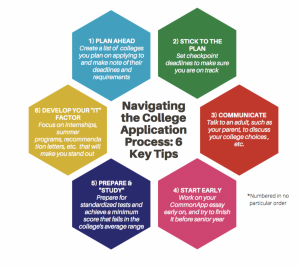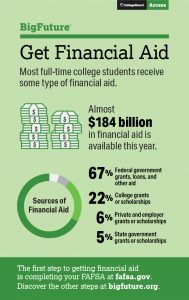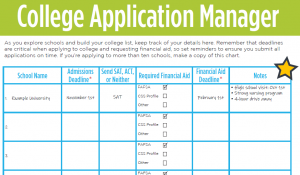The first semester of a new year at IMSA can be overwhelming not only for sophomores but for seniors as well. This fall, the Class of 2023 must balance college applications with academics, extracurriculars, social life, and (of course) sleep. Although the coming months may fill you with dread, remember that hundreds of other IMSA seniors made it through this same challenge before — and you will, too.
Planning and Logistics
First, you should familiarize yourself with the general requirements and deadlines for colleges. In the United States, most schools accept — and IMSA counselors strongly recommend — the Common Application (some colleges exclusively use their own applications, such as the Universities of California, MIT, and Georgetown). In general, application deadlines are on either November 1 or in early January — one notable exception is UIUC, whose special deadline for IMSA is October 1. While browsing individual colleges’ Common App listings and websites, take note of their application deadlines and requirements, as well as their financial aid policies. Some useful information, including terms you should look for, is outlined below.
Regular Decision or Regular Action (RD): Virtually all colleges without rolling admission offer an RD option.
- Deadline: January 1 (approximately, sometimes January 2-15)
- Admissions decision: late February through mid-April
- Non-binding (even if you are accepted, you can commit to another college)
- Result:
- Acceptance
- Rejection
- Waitlist (delayed acceptance or rejection)
Early Action (EA): Applicants who choose the EA deadline (if offered) may have a slightly higher chance of admission to some colleges, but this is not guaranteed. You should only submit your application early if you feel that it already represents your best effort.
- Deadline: November 1 (usually)
- Admissions decision: mid-December
- Non-binding (even if you are accepted, you can commit to another college)
- Result:
- Acceptance
- Deferral (depending on individual college policies, your application may be reconsidered as if it were submitted in the Regular Decision pool)
- Rejection (depending on individual college policies)
Early Decision (ED): Since ED is a binding application, you should make sure that any ED school is your top choice and that you and your family can afford tuition. ED significantly increases your chance of admission. You can only submit one ED application per cycle (you can only submit an ED II if you have not been accepted via any ED I). The only difference between the ED I and II cycles is the deadline, allowing you to decide on applying ED II after you have received any EA and ED I decisions. Note that some colleges may not offer both ED I and ED II (or either).
- Deadline: November 1 for ED I, January 1 for ED II (dates are approximate)
- Admissions decision: mid-December for ED I, late February through mid-April for ED II
- Binding (if you are accepted, you CANNOT commit/apply to another college and you must withdraw all other applications)
- Result:
- Acceptance
- Deferral for ED I only (depending on individual college policies, your application may be reconsidered as if it were submitted in the non-binding RD pool)
- Rejection (depending on individual college policies for ED I)
Restrictive/Single-Choice Early Action (REA): REA is identical to the EA option, except that REA significantly restricts your ability to apply for other colleges with the early (November 1) deadline. REA is much less common than ED, and REA policies may vary between different colleges. For instance, Princeton University’s REA option prevents the applicant from making any binding early application, as well as any early application to a private institution — however, early applications to public institutions are still permitted. REA also increases your chance of admission, but to a lower extent than ED, since REA is non-binding. You should only make an REA application if the school is among your top choices and you have a reasonable chance of acceptance.
- Deadline: November 1 (usually)
- Admissions decision: mid-December
- Non-binding (even if you are accepted, you can commit to another college)
- Result:
- Acceptance
- Deferral (depending on individual college policies, your application may be reconsidered as if it were submitted in the RD pool)
- Rejection (depending on individual college policies)
Rolling Admission: This application option allows you to submit at any time before a certain deadline — the earlier you submit, the earlier you will receive a decision (and the less likely the school has run out of space for you).
Students usually take advantage of Rolling Admission by applying very early to secure at least one college acceptance as soon as possible.

Tips for applying to college | Source: The Viking Press
Test-optional: Many schools have implemented this policy for the 2022–2023 application season, allowing students to choose whether or not to submit their SAT or ACT scores. Some test-optional schools still require scores to award merit-based aid. Some schools accept self-reported test scores on the Common App, but for those that don’t, send SAT score reports through the College Board and ACT scores using the ACT’s own website.
Generally, you should submit your scores only if they are near or above the score of the average admitted student (look at the school’s Common Data Set to find this information). Note that the average score may be skewed upward if a college became test-optional before the pandemic, as students with lower scores probably did not submit them.
Test-required: Some schools, such as MIT, still require one or more sets of SAT or ACT scores. A few require applicants to submit their scores from every SAT and ACT sitting.
If your score is significantly lower than the score of the average admitted student, or you think that it inaccurately represents your abilities as a student, you may reconsider applying to a test-required school — especially due to the very high number of test-optional choices this year.
Test-blind: A few schools, such as Caltech, do not accept SAT or ACT scores at all. Admissions officers will not see your scores, even if you try to submit them.
This may be especially helpful for students with lower scores, as other applicants’ higher scores are not considered. On the other hand, higher-scoring students may have a somewhat lower chance of admission than to other schools.
Letters of recommendation (“recs” or “LOR”): Most schools require a recommendation from your CAC, as well as one or two teacher recommendations — colleges have different definitions of the word “teacher,” with some also accepting letters from SIR mentors, coaches, or extracurricular advisors. You should submit IMSA teacher recommendation requests through Naviance and external recommendations using the Common App. Waiving your FERPA right on the Common App is strongly advised, as it will demonstrate to colleges that because you will not read your own recommendations, recommenders will likely be more honest.
You should choose teachers who have a close relationship with you and can offer detailed (and different) perspectives on your performance in class. Students usually choose to include one from a humanities teacher and another from the STEM field on the Common App — you can only ask two IMSA teachers for recommendations, unless you have permission for more from your CAC. Once you’ve identified these teachers (and other recommenders, if applicable), ask for letters and inform them of due dates as soon as possible to allow more time to write. If you’re applying to UIUC, which is strongly suggested due to its relatively high academic quality and its special relationship with IMSA, don’t worry about the early deadline for recommenders — UIUC doesn’t accept any letters of recommendation. Remember to have in-person conversations with your recommenders first, and remind them of your good qualities and past accomplishments if they ask. You should only submit their emails on the Common App and Naviance once they’ve agreed to write your recommendation.
Common App Personal Statement: This 650-word essay about a more personal topic will be sent to most schools that accept the Common App.
You should put the most effort into the Personal Statement. Because the prompts are very open-ended, feel free to write about (almost) anything you want, such as a significant experience in your life and how it affected you. Try to make your essay reveal some positive aspect of your personality without being arrogant or insincere. Common pitfalls to avoid include: procrastination, excessively elaborate language, controversial topics, and focusing your essay on other people instead of yourself (writing about other people is acceptable, as long as you concentrate on how they have affected you). Many students also choose not to write about their academic interests or first-choice majors because there are opportunities to elaborate on these in the supplemental essays.
Start brainstorming and writing down any thoughts that you have as soon as possible, even if you think they’re not good enough — many applicants discover that a written stream of consciousness is very helpful. If you have an idea that might work, you should try to write a rough draft. Students typically go through at least a few Common App drafts or revisions before submitting the final version, so don’t worry if you feel like starting over. Consider asking 1–3 adults (such as your CAC, teachers, or family members) or previous IMSA students for feedback on your drafts. Try to avoid letting current IMSA students see your drafts and reading theirs, at least before submitting applications, as you may unconsciously affect each other’s writing style and ideas. You can improve your Personal Statement for later deadlines by submitting an application with the first version, editing the Personal Statement, and then submitting others. However, writing different essays is significantly more time-consuming and is not generally recommended.
Supplemental essays (“supps”): In addition to the Personal Statement, most Common App schools require additional (usually shorter) supplemental essays. These essays are unique to each college, so they are almost always the limiting factor for applying to a greater number of schools.
The easiest way to view the prompts is to add the college to your list on Common App, click on its listing from the Dashboard, and scroll down to the College Questions and Writing Supplement links. You should look through each section ahead of time because it is not always clear where every writing prompt is. Common supplemental topics include why you want to attend the specific college, why you are interested in your first-choice major, and an extracurricular activity you’ve done. Many schools also ask unconventional questions ranging from Stanford’s note for your future roommate to Chicago’s infamous choose-your-own-prompt question. The most important parts of managing your supplemental essays are to allocate enough time to write each one and to focus on genuinely showing your passion through the writing, rather than saying what you think the admissions team wants to hear.
Interview: Some schools conduct interviews for certain applicants, which can be an additional opportunity to showcase your personality.
If you are offered an interview after submitting your initial application, you should strongly consider accepting, as a great interview can be a factor that differentiates you from other applicants (and further demonstrates your interest in the college). Prepare for questions covering your aspirations, why you are interested in the college, and what you spend your time on, among other topics. Also bring questions of your own that cannot easily be answered on the school’s website. The interview is only meant to be like a casual conversation, so don’t worry too much or try to say what they want to hear — prepare, but don’t overprepare.
Check your email’s spam folder and answer phone calls from unknown numbers if you’ve received no contact, as many interviewers are volunteers. If you are not offered an interview (by a college that is known to conduct them), don’t view it as a reflection on yourself as an applicant. There are many reasons why a college may not interview a particular student, such as a lack of alumni interviewers in your area.

Financial aid is available from a variety of sources. | Source: College Board
Need-blind and need-aware: Admissions officers for need-blind colleges will never see your financial background, so it will not affect your chance of admission. Need-aware colleges do consider your financial need because they want to afford to support the entire incoming class. Need-aware policies may pose a disadvantage to low-income applicants, while need-blind policies are intended to level the playing field. Keep in mind that while a college may have a need-blind policy, it may not necessarily meet 100% of your demonstrated financial need once admitted.
FAFSA: The Free Application for Student Aid (FAFSA) is a government form allowing consideration for lower tuition at most American colleges. The FAFSA asks for a variety of financial information, including your family’s tax returns from the previous year — if you’re completing the FAFSA in 2022 to enter college in fall 2023, you’ll need your 2021 tax returns. The FAFSA for the following school year always opens on October 1.
The FAFSA is free to send, so you should always complete the form even if you aren’t sure that you qualify for aid (some schools also only grant merit-based aid if you submitted the FAFSA). You can only send the FAFSA to a maximum of ten schools at once, but more can be included by listing ten colleges first, then changing the list and sending the form again once the first group receives your information. Unfortunately, the FAFSA does not ask for any recent changes in your family’s financial situation, so inform colleges of this through either the CSS Profile (if they accept it) or in the additional information section of your application.
CSS Profile: This online application is privately administered by the College Board, and fewer colleges accept it. Unlike the FAFSA, the CSS Profile costs money to send ($25 for the first and $16 for subsequent colleges), can be sent to an unlimited number of colleges, and asks for more detailed and up-to-date information. The CSS Profile also opens on October 1 for the following school year.
Even though the CSS Profile can be expensive, you should still send it (if you can) to all your colleges that accept it — the financial aid benefits will usually outweigh the cost.
Merit-based aid: Some colleges may grant scholarships based on merit, without consideration of your family’s ability to pay. Such awards usually involve separate application questions and sometimes different deadlines, so make sure to research each of your colleges to determine what, if any, merit-based aid they offer.
Net price calculator: Many schools offer net price calculators on their websites, which estimate how much you and your family might pay based on preliminary information. Net price calculators are designed not to take very long, so you should try to complete them (at least for the colleges you know will be more expensive). Keep in mind, though, that their figures are merely estimates and may not match the financial aid offer you actually receive.
Application List

Keep track of the deadlines and requirements of colleges when building your list. | Source: MEFA
Before starting applications, always do your research and decide which colleges to apply to (if you already have a list, skip to the next section). The College Application Plan on the Naviance document page is designed to keep your CAC up to date on your list of colleges and their various requirements.
Factors to consider when choosing colleges include location, quality of academic programs, and cost. You can begin by asking yourself: How much does staying near your family matter to you? Would you like to attend school in a rural, small town, suburban, or urban setting? A small, medium, or large school? A liberal arts college (smaller, undergraduate only, well-rounded education) or a research university (larger, undergraduate and graduate, focus on research and more specific elements of your major)? What is your intended major (undecided is fine in most cases)? How much do you care about academics outside of your intended major? What is the acceptance rate for your intended major (it may be different than the overall rate)? How much can you and your family afford to pay, and how does that compare with the results from net price calculators? If you are unsure about the answers to any of these questions, your college list should represent a mix of preferences so you can make these decisions in the spring. Perhaps most important, though, is how satisfied you would be to attend each college. If a particular college has few redeeming factors, you may want to spend your time applying to a better choice.
There is no magic number of colleges for anyone, but most apply to about 6–12. If you’re particularly ambitious and willing to pay application fees, and you aren’t choosing Early Action for too many schools, you can apply to at most 15 — after this point though, you’ll have significantly diminishing returns on application quality (the Common App will also limit you to 20 colleges, and you can’t remove any once you’ve applied). You can eliminate colleges for any reason, such as cost or campus environment, if your list becomes too long. Two or three of these colleges should be “safety schools” that you are almost certain you will be accepted to (of course, you can add more to have additional options come spring). The rest should be mostly “targets,” with a reasonable chance of acceptance, and some “reaches,” with a fairly low chance (but that are still worth applying to as your top choices).
You can roughly estimate these chances using Naviance’s bar graphs, which detail IMSA’s application and acceptance numbers for a particular school in recent years, and the Scattergrams, which compare your GPA and SAT/ACT scores with those of past accepted and rejected applicants. Both of these tools are accessible by searching for a college name from the Naviance homepage — note that you may have to use very specific search terms, like “Urbana-Champaign” instead of “UIUC” — and clicking the link under the acceptance rate. This data can be used to classify schools in terms of your approximate admission chance and to decide whether to submit scores to test-optional schools. However, please remember that the other elements of your application, such as essay and recommendation quality, are also incredibly important — they demonstrate to colleges who you are as a person, which goes far beyond a simple set of numbers.
Time Management
The most difficult part of college application season may be finding enough time for all your obligations. This can be accomplished in two ways.
Start your applications as early as possible! This will not only minimize the amount of time you need to spend daily, but it will also allow room to consider more factors and make significant application decisions, such as applying to more or different schools. If that doesn’t motivate you, think of how great it will feel once you’ve submitted, knowing you truly applied with your best effort — and of how proud your friends, family, teachers, and CAC will be (especially compared to the alternative).
Once you’ve started, continue! Do not procrastinate under any circumstances. Break up each essay into smaller tasks if you need to, so the writing process doesn’t seem as daunting. Try to work on your essays at least a little bit every single day, so it becomes part of your routine and thus easier to make progress.
2. Reduce commitments
If time management isn’t enough to get all your work done, you may have to reduce your other commitments to prioritize college applications. This doesn’t mean you should drop all your clubs and extracurriculars, just dedicate less time to them if necessary — tell your club leaders or advisors that you have to step back for a bit. You can always return to them in the spring.
Bottom Line

Encourage both yourself and others as you navigate your challenging first semester. | Source: Cheryl’s Cookies
While your college application should be individual and unique to you, you don’t have to do it alone. Asking for help and support is one of the most important parts of the first semester senior experience. The CAC team is an excellent resource, so take advantage of their skills by scheduling meetings outside of the mandatory one in September (and don’t rely on emails, since their inboxes fill very quickly and a meeting will give you individual attention). Feel free to ask them for any kind of advice or support, or to read your essays (especially the Personal Statement). Friends and family are also a great support system for many students — you should ask for help, even if you feel like you don’t need it. On the flipside, understand that your fellow students may also be facing challenges, so refrain from judging others and be there for them if you can.
If you’re having trouble motivating yourself to work, try something different — problems will not solve themselves unless you take action. For example, if you can’t write well by yourself, try working with friends who can help keep you focused (or if your friends are distracting you, find an isolated location to work). When you want to write, but are stuck on a specific portion of your application, such as the Personal Statement, try switching over to supplemental essays instead so you still use your time effectively.
Don’t think of the college application process as the culmination of your entire life up to this point. While it is not inconsequential, many students, especially at IMSA, spend too much time stressing over it — be sure to dedicate enough time to your friends, family, and mental health, too. Also keep in mind that the admissions offices for more selective schools receive very many applications, meaning that they are forced to reject many highly qualified applicants. Therefore, college admissions is somewhat dependent on luck — a rejection does not, in any way, reflect on your personality or accomplishments. No matter where you end up, it is your attitude that will determine your future.






Be the first to comment on "A Guide to College Application Season"